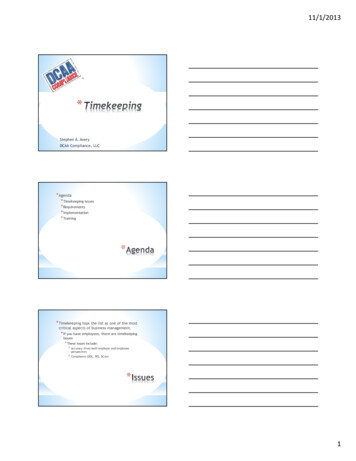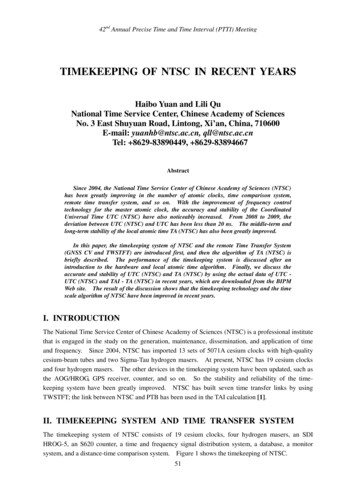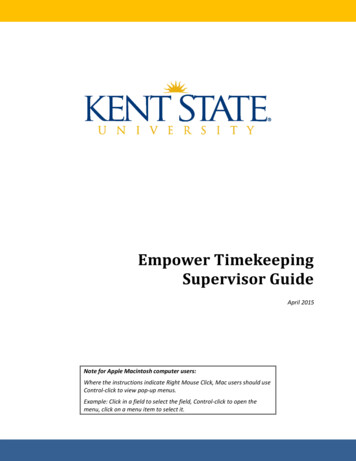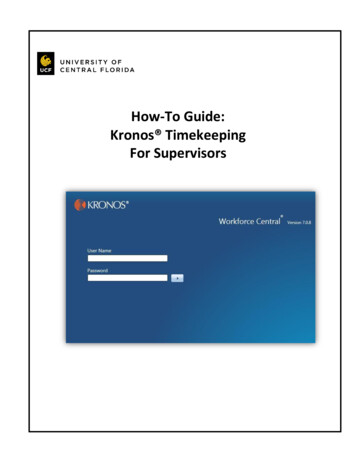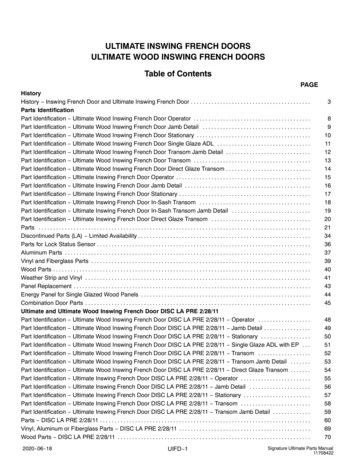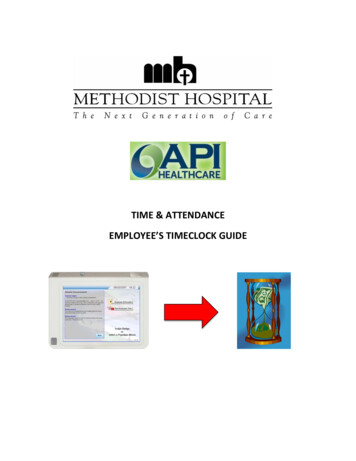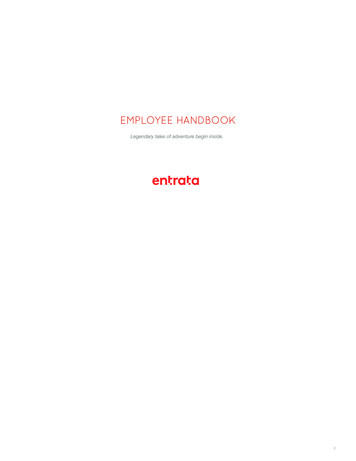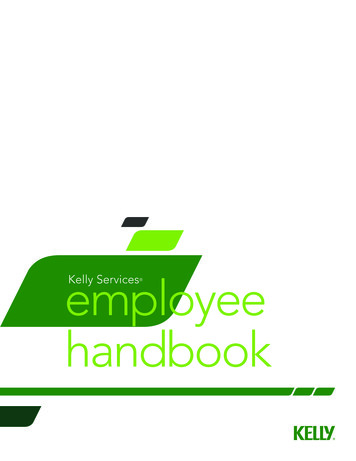
Transcription
THE ULTIMATE GUIDE:TimekeepingSuccess forLaw FirmsTHE ULTIMATE GUIDE: Timekeeping Success for Law Firmswww.bellefield.com1
The information provided in this e-book is strictly for the convenience of our customers and is for general informational purposes only. Publication by Bellefield.com does not constitute anendorsement. Bellefield.com does not warrant the accuracy or completeness of any information, text, graphics, links or other items contained within this e-book. Bellefield.com does notguarantee you will achieve any specific results if you follow any advice in the e-book. It may be advisable for you to consult with a professional such as a lawyer, accountant, architect, businessadvisor or professional engineer to get specific advice that applies to your specific situation. 2014 Bellefield Systems. All rights reserved.THE ULTIMATE GUIDE: Timekeeping Success for Law Firms2
INTRODUCTIONCHAPTER 1: Understanding Timekeeping In Legal1.1 The Fundamental Faceoff: Time Entry Vs. Time Capture1.2 Two Types Of Time Entry: Doing It Now Vs. Saving For Later1.3 How Attorneys Benefit From Contemporaneous Time Entry1.4 The Problem With Reconstructive Time EntryTHE ULTIMATE GUIDE:CHAPTER 2: Timekeeping’s True Purpose: AccuracyTimekeepingSuccess forLaw FirmsCHAPTER 3: The Role of Mobility in Timekeeping2.1 What Is Accuracy In Timekeeping?2.2 The Role Of Time Velocity In Law Firm Operations2.3 In The Future Of Legal, Accuracy Will PrevailCHAPTER 4: How to Select a Mobile Time Entry Vendor4.1 The High Stakes Of The Vendor Selection Process4.2 Three Often-Overlooked Goals Of Mobile Time Entry Vendor Selection4.3 How To Assemble The Right Team: No Selection Without Representation4.4 Three Key Questions To Ask Prospective VendorsCHAPTER 5: The Human Element of Timekeeping Success5.1 How To Facilitate Firm-Wide Timekeeping Adoption5.2 The Power Of Habit5.3 How Attorneys Can Embrace New Timekeeping Habits5.4 How Timekeeping Affects Staff Morale At The FirmCHAPTER 6: Why Timekeeping Should Be a Priority at All FirmsCONCLUSIONTHE ULTIMATE GUIDE: Timekeeping Success for Law Firms3
IntroductionTime entry isn’t necessarily what most would consider to be a sexy topic,especially for attorneys. It’s not just attorneys that shake their proverbialfist at time entry. Many law firms continue antiquated and inefficient timeentry practices, which means that firm administrators, legal assistants andother staff are burdened with some aspect of time entry, from completion toaccuracy.Time entry, however, plays an important part to both the firm as a whole, andfor the individuals within the organization. Revenue, growth, client loyalty,compliance and morale are all affected by your firm’s timekeeping practices.In addition to the above, your competitive edge depends heavily on accuracyin time entry.In this eBook, we’ll take you through everything you need to know abouttimekeeping. We’ll help you understand the difference between commonmethods of timekeeping, introduce the concept of mobility and why the futureof legal depends on it, and guide you through the vendor selection process.THE ULTIMATE GUIDE: Timekeeping Success for Law FirmsIntroduction4
CHAPTER 1:UnderstandingTimekeepingin LegalTime is money, but we’ve heard that before.All firms keep time, but the method andresulting accuracy varies. Let’s begin bydiscussing the most prevalent timekeepingmethods used by the legal industry today:time entry and time capture.THE ULTIMATE GUIDE: Timekeeping Success for Law FirmsChapter 1: Understanding Timekeeping at Law Firms5
The Fundamental Faceoff:TIME ENTRY vs. TIME CAPTUREWill your attorneys manually enter their time or will they rely on technologyto record and analyze their behaviors to generate time cards? Perhaps both.The first key lesson in understanding timekeeping is to distinguish betweentime entry and time capture.FIRST, LET’S EXPLORE TIME ENTRYTime entry relies on the individual attorney to manually enter his or her time into a timekeeping system. There are two ways to conduct time entry:1. Reconstructive Time Entry: When you think of time entry, you are likelythinking of the grueling process that includes looking back through yourcalendar, emails and call logs to estimate the time spent on each task, caseor initiative. This approach is referred to as reconstructive time entry, as youare literally “reconstructing” your schedule in order to determine how yourtime was spent.2. Contemporaneous Time Entry: This is achieved by recording timeimmediately after a task has been completed. Technology is an ally insuccessfully practicing contemporaneous time entry, as it is now possible torecord time on a mobile device, anytime and anywhere.Reconstructive time entry and contemporaneous time entry are not mutually exclusive. Often, timekeepers will practice a combination of both time entrymethods, keeping track of a portion of their time contemporaneously and using reconstructive time entry to fill in the gaps.THE ULTIMATE GUIDE: Timekeeping Success for Law FirmsChapter 1: Understanding Timekeeping at Law Firms6
SO WHAT ABOUT TIME CAPTURE THEN?Time capture, on the other hand, relies on different mechanisms to tallyand analyze time. Time capture uses software and hardware to monitor atimekeeper’s activities and create an automated report regarding how timewas spent. The software runs on attorneys’ desktop computers, phones,copiers, and other devices to track work-related activities that take placethroughout the day. The software presents and summarizes the activity dataso the user can code properly and convert those into time entries. TimeCapture is an “automated” form of reconstructive time entry and often usersare presented with more data that needs to be sorted out before it can beconsidered a time entry.Ultimately, you may not decide to choose between time entry or time capture,but to embrace both. After all, timekeeping is often completed on a spectrum.You won’t always be able to “do it right now,” and you are hopefully not“leaving it all for later.”In fact, the idea of embracing both is often necessary if time capture isimplemented. In order to verify that the software is operating properly andtime is allocated correctly, attorneys will need to keep track of time manuallyand compare their records against the time capture logs.Speaking of which, let’s dive into a bit more detail on those two types of timeentry that we mentioned earlier.THE ULTIMATE GUIDE: Timekeeping Success for Law FirmsChapter 1: Understanding Timekeeping at Law Firms7
Two Types of Time Entry:Doing It Now vs. Save For LaterWHAT IS CONTEMPORANEOUS TIME ENTRY?Contemporaneous, according to the Merriam-Webster dictionary, means“existing, occurring or originating at the same time.” Applied to the practiceof time entry, contemporaneous time entry occurs when time is recorded asa task is being completed. It’s real-time time entry.Until recently, contemporaneous time entry in the legal field wasn’t practical,or even possible because time entry was confined to the office. Most attorneysare always on the go spending the majority of their time out of the office atmeetings with clients, court dates, or logging hours at home during eveningsand weekends, therefore making contemporaneous time entry not a feasibleoption.THE ULTIMATE GUIDE: Timekeeping Success for Law FirmsHowever, mobile devices have changed the way that attorneys work and havepresented new opportunities to increase productivity on the go. Mobile timeentry brings timekeeping to the field allowing legal professionals to entertheir time as they finish each client meeting, phone call or task by dictating orentering time into an app on their smartphone.Why not just save it for later? You could. And, that’s probably what you’vebeen doing up until this point. Contemporaneous time entry contrasts withreconstructive time entry, which occurs when time is calculated usinghistorical data such as calendars, phone logs and emails. However, there is agrowing body of research that suggests that reconstructive time entry is lessaccurate and takes more time to complete than contemporaneous time entry.Here are a few benefits of practicing contemporaneous time entry, or in otherwords, “doing it now.”Chapter 1: Understanding Timekeeping at Law Firms8
How Attorneys Benefit From Contemporaneous Time Entry It allows you to work the way you work. You’ve just finished a meeting at arestaurant? Great. You’re on the subway, catching up on emails? Awesome.The beauty of mobile time entry is that it is right there with you, whereveryou are, no matter whatever you are doing. As you take advantage of smallchunks of time here and there to get things done, you can also record thattime immediately. Instead of time entry being an extra “thing” that you haveto worry about, you can keep it under control as you go throughout your day. Save time by avoiding reconstructive time entry. For all of you attorneysout there that have at one time or another in their legal careers gottencaught behind the proverbial eight ball and have reconstructed your time,you know that it can be a pain in the.ahem.loafers. Searching throughthe calendar and digging through emails and phone logs is boring andstressful - especially when there are numerous other more important itemsof business you could be working on at that time.THE ULTIMATE GUIDE: Timekeeping Success for Law Firms Increase accuracy in timekeeping so that you don’t leave money onthe table. When you record your time as you complete a task, the timethat it took you to complete the task is fresh in your mind. As time goes on,remembering the amount of time that it took to complete that task becomesmore of an estimate or a guess. In fact, according to Attorneys at Work,attorneys who enter time on a monthly basis can lose up to 55 to 70 percentof their time. That’s a lot of time that isn’t being billed, which can leave alasting mark on revenue over the course of a year. On the other hand, firmsthat keep contemporaneous time tend to generate 25 to 40 percent higherrevenues than firms that do not keep contemporaneous time. This is a realincentive to improve! Time entry becomes a habit: Once you start realizing the benefits ofentering your time contemporaneously anywhere you are, it will become thenew normal, and even something you can enjoy and take pride in! Habitsare quite powerful.we will touch more on that later.Chapter 1: Understanding Timekeeping at Law Firms9
The Problem with Reconstructive Time EntryYou’ve probably already caught wind of the fact that we aren’t the biggest fans of reconstructive time entry as an approach.We have good reason for this - as there are some serious drawbacks to “saving it for later.” It becomes more burdensome. The “do itlater” approach more often than not translatesto “overwhelming” which, in turn, becomes adaunting task in the end. Combing through calllogs, calendars and emails in order to “makeyour best guess” of how your time was spentover the course of the time period in questionbecomes tedious and time consuming. Thismethod, as you can guess, is very ineffective.THE ULTIMATE GUIDE: Timekeeping Success for Law Firms Accuracy suffers. “Making your best guess”certainly doesn’t sound like a path to accuracy.Realistically, can you remember exactly whatyou worked on five or more days ago? Whenyour time entries are inaccurate, that meansthat you are not billing based on the actual workcompleted, but rather on your “best guess” ofthe work completed. This can mean leavingmoney on the table, or worse, compromisingclient relationships. Morale is affected. When timekeeping isleft for later, there is a significant amount ofunnecessary stress created in the organization.Legal secretaries scramble to assist in enteringtime, in the midst of several other competingpriorities. The billing department wrestleswith billing issues caused by inaccurate timerecords and the cycle continues.Chapter 1: Understanding Timekeeping at Law Firms10
CHAPTER 2:Timekeeping’s TruePurpose: AccuracyNow that we have covered the different manners in which timeis entered, exactly how accurate are those time records?THE ULTIMATE GUIDE: Timekeeping Success for Law Firms11
Has your firm ever measured the time elapsed between the time that the workwas completed and when time was recorded for such work? For most firms,the average is about 5 to 7 days. Why does this matter? If you recall from thediscussion above, it matters because the longer it takes to record an activity,the less likely you are to remember. Most attorneys like to say “It will all evenout eventually, right?” The truth is, it probably will not.Even a small leakage in timekeeping can cost your firm hundreds of thousandsof dollars in revenue per year. On average, these small omissions in billablehours cost your firm between 20,000-40,000 annually, per individual. Thisamounts to between 2-4 million for a 100-attorney law firm.In today’s competitive market, law firms cannot afford to let hard-earned billablehours slip through the cracks. That’s why timekeeping accuracy is crucial.What is Accuracy in Timekeeping?Accuracy can be measured by the time between when the work is done and when the time is actually recorded. The closer this number is to zero, the more accurateit is. This is what we call “Time Velocity.” When “Time Velocity” gets larger than 1 day, accuracy is severely compromised, which almost always equates to a loss ofbillable time. Accuracy is intrinsically related to “Time Velocity”. The shorter the velocity is, the more accurate your time records are. The opposite is also true.WHY YOUR FIRM IS LEAKING REVENUEUnfortunately, since reconstructive time entry is the most widely-practiced method of time entry today, most firms are plagued with billing inaccuracies and fail tomeet their maximum revenue potential. In a recent article, Fred Esposito, stated that lawyers who reconstruct their time weekly tend to lose 25 to 30 percent oftheir time, and those who enter time on a monthly basis can lose as much as 55 to 70 percent.THE ULTIMATE GUIDE: Timekeeping Success for Law FirmsChapter 2: Timekeeping’s True Purpose: Accuracy12
The Role of Time Velocity in Law Firm OperationsDo you have timekeeping data available in real-time or does it have to be submitted, calculated and analyzed manually? If time is recorded as things happen, at atime velocity of 0, you have real-time information. Real-time information can considerably enhance your firm’s operations: Forecasting: When you have favorable time velocity and access to realtime information, the finance and executive committees can run reportsand are able to do a forecast analysis of what your billings are going to beat the end of the month. The quality of this information is higher when youhave access to real-time information, as opposed to information that is aweek (or more) old. This is of particular importance when you need to relyon up-to-date information to make financial decisions for your firm. If, forexample, your time entry is one to two weeks late, or even four weeks late,those forecasts are useless. Reporting: When data is collected in real-time, you have access to a quicksnapshot of where the firm stands on key performance indicators at theclick of a mouse. Real-time reporting allows you to make faster and moreaccurate decisions based on the state of affairs today, without the data lagthat exists through conventional time entry methods. Retainer Management: Law firms work on a retainer model for a reason- in order to ensure payment for services. As many cases exceed the initialretainer, additional funds may be required in order to complete the workassociated with a particular matter. That’s where tracking time against thisretainer amount becomes critically important. In many larger firms, thesecases require a team effort. Several team members are assigned to thecase. Without real-time access to billables associated with a case (becausenot all of the team members are entering their time contemporaneously),it is easy for the firm to exceed the retainer without prior warning. Withoutthe ability to predict this, the firm then runs the risk that the client willnot pay the new balance associated with exceeding the retainer, therefore,defeating the entire purpose of the retainer. Real-time timekeeping recordson the other hand, can help you keep tabs on the hours billed against aretainer, allowing attorneys to more effectively manage their billable hours.The more timely the information, the better, when it comes to maximizing efficiency and managing your firm’s operations for profitability and growth - and acompetitive advantage!THE ULTIMATE GUIDE: Timekeeping Success for Law FirmsChapter 2: Timekeeping’s True Purpose: Accuracy13
In the Future of Legal, Accuracy Will PrevailAlthough we avoid using buzzwords and phrases like, “big data,” it isimportant to acknowledge that one of the products of the information agethat we live and work in is yielding billions upon billions of pieces of data eachday. When analyzed properly, this data provides intelligence to help us makebetter decisions. Law firms and their clients are no exception.With the economy being what it is today, almost all companies are usingdetailed analytics to guide business decisions. From the client’s point of view,each paid invoice is a piece of data. When averaged with other data points,a “normal” is established for a given case or matter. This helps the clientestablish a clear understanding of the typical resources required to completetheir work.For example, consider a patent litigation case. The client may have workedwith hundreds of law firms doing similar patent litigation. If those invoicesare analyzed by task and activity codes, it can be determined how muchtime is spent working on each piece of that particular case. Using analysisto establish norms based on past codes and working with other firms, clientsare able to establish expectations for the resources your firm requires to getthe job done. For the above patent litigation case, the client may determinethat 10% of time should be spend on communication, 12% on planning, etc.THE ULTIMATE GUIDE: Timekeeping Success for Law FirmsThe key consideration for law firms is this: how accurate are your timekeepingpractices? If the firm is not keeping time contemporaneously, the attorneymight lump all of the entries together, rather than provide specific designationsfor each code. However, when the client reviews the invoice and analyzes thetime spent, they may begin to scrutinize how much time is truly being spenton each task. Since the client has established ranges of what is considered“normal,” the client will determine that the firm is outside of this range iftimekeeping is not accurate.When the time comes for a client to make a decision as to which firm shouldbe assigned the next patent litigation case, most, if not all, clients will be guidedby their data. The law firms who are closest to the client’s range of normal andacceptable will win the client’s business time and time again. On the other hand,if your firm becomes the outlier due to the detail and accuracy of your timeentries, you will likely have a much harder time getting new cases.Clients can now garner large amounts of data about your firm and how itstacks up to other firms in the legal industry. This data comes strictly fromyour firm’s timekeeping practices. It doesn’t come from anywhere else. So,how accurate are your time entries? The more accurate you are, the moreyou will win.Chapter 2: Timekeeping’s True Purpose: Accuracy14
CHAPTER 3:The Role of Mobilityin TimekeepingTHE ULTIMATE GUIDE: Timekeeping Success for Law Firms15
Mobility has changed the world and the legal industry is no exceptionto experiencing this change. The way that we work and communicate hasshifted. While there are positives and negatives to any change, technologyhas enabled today’s legal professionals to be more productive and responsiveas they carry out their daily routine. Mobility, after all, begins the moment thatwe leave our desk - even if it is to walk to the water cooler.In fact, by the end of 2014, it is expected that there will be more mobiledevices than people on earth. Attorneys are heavy users of these devices, withover 91% owning a smartphone.Our productivity, often driven by the apps that we choose, is enhanced andenabled to take on new life with our ever-expanding access to technology.One of the most notable ways that mobility has helped attorneys and lawfirms become more productive is through mobile time entry. Mobile time entrymakes true contemporaneous time entry possible for the first time in history.An increasing number of firms are realizing the benefits of contemporaneoustimekeeping practices and embracing mobile time entry. As you begin to diveinto the benefits that mobile time entry can offer, here are three things thatyou need to know to get started:THE ULTIMATE GUIDE: Timekeeping Success for Law Firms The argument for the need for time capture has evolved. “Back inthe day ” (circa 2005), there was a strong and compelling argumentfor time capture solutions. After all, there was no feasible way to practicecontemporaneous time entry “on the go” at that time. Time capture was thebest possible solution for tracking time electronically as attorneys workedin and out of the office. However, times have changed. We now have timeentry solutions that make contemporaneous time entry not only feasible,but desirable. It works the way that attorneys work. (Finally!) Mobile time entry worksas an extension of how you do - on the go. You can now enter your timewherever, whenever. This allows you to record your billable time in real-timewithout the hassle of reconstructive time entry. Excellence in time entry is now possible. Attorneys can be compliantwith time entry policies without the bother of completing time entry tasks.What’s best for the firm is now in line with what is best, practical andconvenient for attorneys.At this time, approximately 10% of attorneys are using their mobiledevices to perform mobile time entry. That number is expected to increasesignificantly over the coming years, as mobile devices are increasingly beingused to maximize productivity beyond email.Chapter 3: The Role of Mobility in Timekeeping16
CHAPTER 4:How to Select aMobile TimeEntry VendorThe vendor selection process can be tedious and timeconsuming. In this chapter, we’ll discuss how to simplifythe process by enlisting the right team members andprovide tips on things to look out for in a prospectivesolution.THE ULTIMATE GUIDE: Timekeeping Success for Law Firms17
The High Stakes of the Vendor Selection ProcessThere are several common misconceptions that exist around mobility,particularly the idea that mobility begins and ends with an app. The idea that“we just need an app” to achieve mobility can easily lead you astray in thevendor selection process. After all, mobility demands that you turn your ITdepartment into a 24x7 operation with global reach, developing an expertisewith thousands of devices or else your firm will fail to achieve true anytime,anywhere, and from any device productivity. That’s no small task.While making this transformation is not necessarily easy, it is important fortoday’s firms. That’s why the vendor selection process for a mobile time entrysolution is so critical. The wrong decision can cost future adoption rates,usability and productivity. Your firm cannot afford vendor selection mistakes,so make sure you can commit to anytime, anywhere mobile productivity - notjust an App.Three Often-Overlooked Goals of Mobile Time Entry Vendor Selection#1: Achieve True MobilityThe App is just the beginning of a mobilitysolution. The true promise of mobility is to enablepeople to get work done anytime, from anywhere,and on any device.THE ULTIMATE GUIDE: Timekeeping Success for Law Firms#2: Prevent Leaked RevenueThe whole point of practicing mobile time entryis to enable contemporaneous time entry, whichincreases billing accuracy. As we discussedearlier, accuracy is an important factor in thefirm’s financial success. For this reason, it isimportant to keep this goal in mind when enteringinto the vendor selection process.#3: Drive Timekeeping ComplianceAn app that provides the functionality to entertime is only part of the answer. Your attorneyshave to be willing to actually use it if you aregoing to increase compliance with timekeepingpolicies and experience the benefits of mobiletime entry.Chapter 4: How to Select a Mobile Time Entry Vendor18
How to Assemble the Right Team:No Selection Without RepresentationTechnology is changing law firms as we now know them, presenting new decisions that can have a direct impact on revenue, morale and operations.Here are the roles within the firm that should be included in the vendor selection process in order to ensure that all angles are covered.IT Staff: This is perhaps the most obviousinclusion in the vendor selection process. TheIT team will add critical input into prospectivesolutions and provide insight into how thesolution will tie into the existing infrastructure aswell as how support will be handled.THE ULTIMATE GUIDE: Timekeeping Success for Law FirmsAttorneys: It is important to involve attorneysin the vendor selection process to determinewhether a prospective solution is likely to beused several times per day, as mobile time entrydemands. The needs of the attorneys must bemet in order to drive adoption of the chosensolution.CFO/Administration: Anything that impactsthe law firm’s revenue should be of interest tothe CFO. Now, more than ever before, the CFOneeds to be involved with the vendor selectionprocess to ensure that technology improvementsare positioning the firm for future growth andfinancial success.Chapter 4: How to Select a Mobile Time Entry Vendor19
Three Key Questions to Ask Prospective VendorsNow that you’ve assembled your vendor selection team, here are a few questions that you should ask prospective vendors, in order to compare offerings:#1: How Will Users Receive Support Anytime?An App is just software, and as such, userswill need support. Traditionally, the expectationhas been that a member of the IT staff wouldbe available to help from 8am to 6pm duringweekdays. Now that the attorney has the ability(and the expectation!) to work anytime, they willexpect that support be available when they needit. This means that you now work 24/7.THE ULTIMATE GUIDE: Timekeeping Success for Law Firms#2: Is Support Able To Reach Anywhere?Traditionally, the expectation has been that amember of the IT staff would be able to walk toan attorney’s desk and fix their PC as needed.Now that attorneys have the ability (and theexpectation!) to work from anywhere, they willexpect your assistance in helping them whereverthey are, whether it is from a 1000 miles awayor even from a different country. This means thatyou now need global reach and the ability to getthings fixed without you being physically present.#3: Is Your Solution Available on Any Device?Traditionally, the expectation has been thatmembers of the IT staff would keep PCsrelatively locked-down and with a standardizedconfiguration to facilitate support andtroubleshooting. Now that BYOD gives attorneysthe ability (and the expectation!) to work on anydevice, it is expected of IT personnel to knowan attorney’s device of choice as well as theattorneys themselves.Chapter 4: How to Select a Mobile Time Entry Vendor20
CHAPTER 5:The Human Elementof TimekeepingSuccessSo, you have a formal time entry policy at your firm and you’veempowered your attorneys to enter time contemporaneouslywith a mobile time entry app. Congratulations! Unfortunately, thisdoesn’t mean that your attorneys are going to jump on board.THE ULTIMATE GUIDE: Timekeeping Success for Law Firms21
How to Facilitate Firm-Wide Timekeeping AdoptionMaking the decision about which time entry solution to provide might be an administrative role, but encouraging your attorneys to embrace mobile time entry is afunction of leadership. Here are a few ways that you can empower your attorneys to enter their time contemporaneously: Educate attorneys on the benefits of entering their time as it happens,contemporaneously. Remember, accurate time entry doesn’t just benefitthe attorney, it also benefits the firm. When clients receive more accuraterecords, they stay happy and loyal.Put initiatives in place to encourage attorneys to enter time. We all likesome rewards, not always to be punished. Assess risk. Help attorneys understand how reconstructive time entry canbe much more time consuming and risky for the firm. Start slow. This may be a big change for some attorneys, so give themsome time to realize the benefits once they have the right app on theirhands.As a firm, you can lessen the barriers and decrease the mechanics involved in time entry by introducing tools that enable and empower attorneys to enter theirtime contemporaneously.THE ULTIMATE GUIDE: Timekeeping Success for Law FirmsChapter 5: The Human Element of Timekeeping Success22
The Power of Attorney HabitWhile policies and technology play an important role in making the shift tomobile time entry, there is another element to consider: human habit. Withouta change in the habits of attorneys, your firm’s new approach to time entrywon’t stand a chance.Good and bad habits have a profound effect on our lives. Daily habits mayseem small and insignificant within the scope of the day or week, but canamount to dramatic and transformative results over time. Habits are thebackbone of productivity, job satisfaction, career success and growth. This isespecially true in the legal environment.In his book, The Power of Habit, New York Times Investigative Reporter CharlesDuhigg talks about the everyday behaviors that lead to our ultimate successor demise. On the up side, we make changes
2.2 The Role Of Time Velocity In Law Firm Operations 2.3 In The Future Of Legal, Accuracy Will Prevail CHAPTER 3: The Role of Mobility in Timekeeping CHAPTER 4: How to Select a Mobile Time Entry Vendor 4.1 The High Stakes Of The Vendor Selection Process 4.2 Three Often-Overlooked Goals Of Mobile Time Entry Vendor Selection


